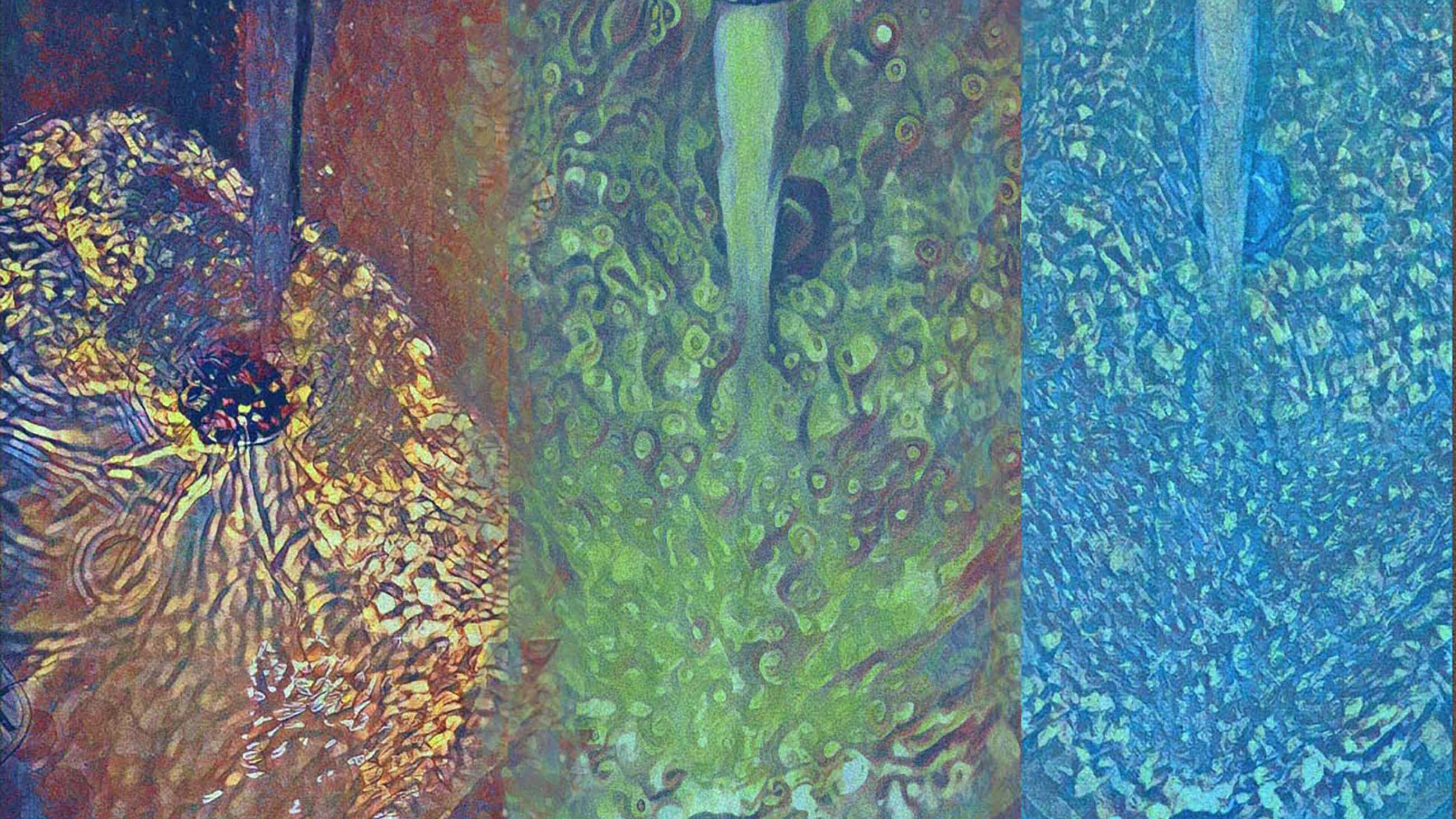Can Recycled Sewage Water Help Alleviate California’s Water Woes?
In July 2014, in the middle of one of the hottest and driest summers in California history, Silicon Valley celebrated the opening of its newest water supply facility: a $72 million purification plant that can produce clean water from sewage. A small crowd of local and state officials stood on stage. Before them sat an audience of nearly 200, and behind them loomed the new Silicon Valley Advanced Water Purification Center. Its pipes and filters would take treated sewage effluent from San Jose’s wastewater treatment plant across the street and turn it into fresh water to irrigate the landscaping at the new Apple headquarters, the Villages Golf and Country Club, and the new Levi’s 49ers stadium in Santa Clara, among other sites.
The plant’s completion was 10 years in the making, and officials on the stage planned to christen the opening of the plant with a symbolic watering of two potted peach trees. They lifted their beakers of water, which just days prior had been flushed down Silicon Valley’s toilets, and held them high as if raising Champagne flutes for a toast.
But they didn’t water the trees. Instead, taking everyone by surprise, they brought the water to their lips and drank.
Pam John, the center’s senior engineer, clapped from the audience. She wasn’t shocked at the board’s decision to toast the facility with a drink — she’d tasted purified water from plants like this many times — but she knew most of the audience would be. After all, that water was extracted not just from sewage from people’s homes, but also from the stuff flushed down the toilets and drains of hospitals, laboratories, and manufacturing plants.
While the event that summer was simply a demonstration, it was illustrative of much longer term ambitions for the plant, which include using the water it treats to recharge groundwater basins in Santa Clara County and, if regulation is passed, to someday pipe the water directly to customers.
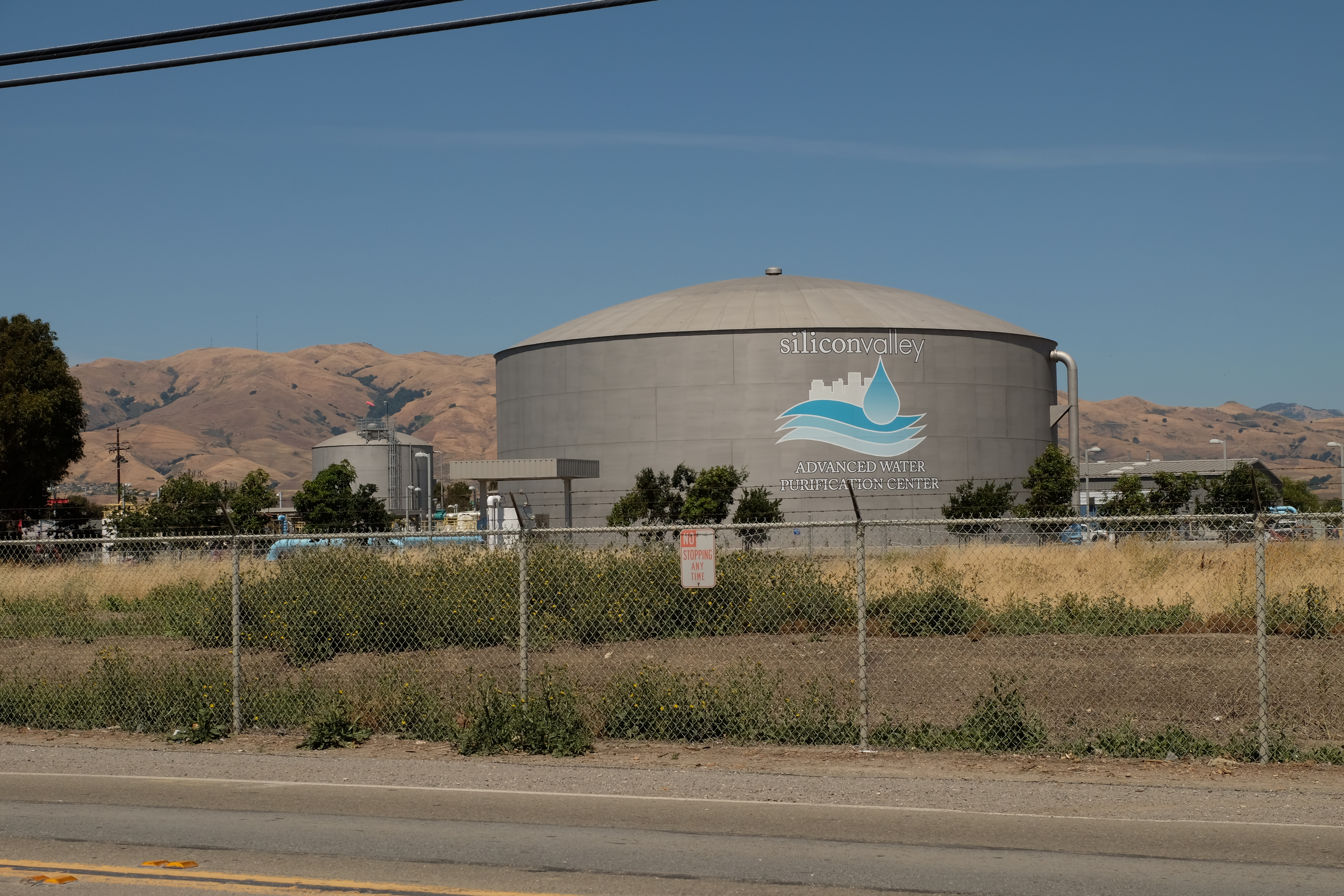
Reusing wastewater isn’t a new concept. Many countries have long used recycled water for non-potable purposes like irrigation and landscaping. And some, including the United States, Israel and Australia, also treat recycled water so that it can added to groundwater supplies. This process, known as “indirect potable reuse,” is supposed to help keep consumers safe — and it has been used in California for over 40 years. In theory, allowing this treated, recycled water to percolate through an aquifer’s natural soil and rock filtering systems sufficiently dilutes any remaining contaminants — and it also gives managers, water quality engineers, scientists, and technicians time to detect and respond to any potential hazards.
California’s current regulations, enacted in 2014, require recycled water to stay underground for two months before it is withdrawn for drinking. Many water utilities seem not to mind: Drawing drinking water from an aquifer helps preserve the illusion that it’s “natural,” even if it was sewage just a few months ago.
But not every utility that wants — or needs — to recycle water has a handy aquifer beneath it. That leaves some areas looking hard at the prospect of what’s known as “direct potable reuse.” In short, that’s sending sewage first for treatment, and then directly to your tap.
This method, which in 2013 was active in fewer than a dozen municipal water plants around the world, according to a report by the Australian Academy of Technological Sciences and Engineering, could be implemented more or less anywhere. In Texas, for example, severe drought drove the city of Big Spring to build the first direct potable reuse plant in the U.S. in 2013. The next year, the nearby city of Wichita Falls also implemented the process, though only as a temporary emergency measure which has since been taken offline.
The city of El Paso, Texas is now preparing to use direct potable reuse to supplement its water supplies — and its the sort of solution that a growing number of cities might be forced to consider. The United Nations estimates that water scarcity is already affecting more than 40 percent of the world’s population, and the problem is only expected to get worse amid a changing climate. Although California is experiencing a welcome respite from its years-long drought, the state’s water woes are far from over.
“California needs more high quality water, and recycling is one way of getting there,” declared California Governor Jerry Brown’s 2014 California Water Action Plan, the administration’s signature response to the drought that had been crippling the state. That year, the state government enacted regulations to govern additions of recycled water to underground drinking water sources. Since then, they have streamlined permitting processes, provided financial and technical support for water recycling projects, and convened an expert panel to create recommendations for regulations for recycled water.
The federal government is enthusiastic about water reuse too: A grant last year provided $30 million of funding to seven different recycled water projects in California.
Those projects, the largest of which is in Orange County, use indirect potable reuse. But once regulation is passed, the Silicon Valley plant is poised to become the state’s first direct potable reuse project. Planning to purify millions of gallons of water per day, it would likely also be the largest in the country, though Zach Dorsey, director of communications at the trade organization WateReuse, said utilities with indirect potable reuse projects may come to decide that moving to direct makes sense.
While drinking water extracted from sewage may sound profoundly unappetizing, as the state continues to grapple with limited water resources, public health experts say there needs to be discussion of the potential risks and benefits of “toilet-to-tap” technology.
On a cloudless day in March 2015, four years into the drought and one year after Governor Brown declared it a state of emergency, Pam John was preparing to give a tour at the Silicon Valley Advanced Water Purification Center in San José, California. At 56, she’s cheerful and energetic, with big sunglasses and a red-and-black jacket. Over 22 years working in the Santa Clara Valley Water District, John has witnessed the explosion of the region’s economy and stretching of its water resources first-hand. And as one of the senior civil engineers who helped design the Advanced Water Purification Center, and the facility’s manager from January 2015 until her retirement last May, she knows the place inside and out.
From the street, it doesn’t look like much. A few low-slung buildings and some large tanks and pipes sit in an open field behind a chain-link fence. But this plant, set on the southern edge of the San Francisco Bay, is poised to become the first in Northern California to purify recycled sewage to replenish groundwater aquifers. It could also be the first to send the water directly to consumers if the state approves new regulations for direct potable use, with the potential to serve up to eight million gallons of drinkable water daily.
Though the water it produces is now used for non-potable purposes only, it’s designed as a demonstration plant, John explains. “When we built this plant, we knew what we wanted,” she says. She gestures animatedly as she speaks. “We wanted to get to potable reuse.”
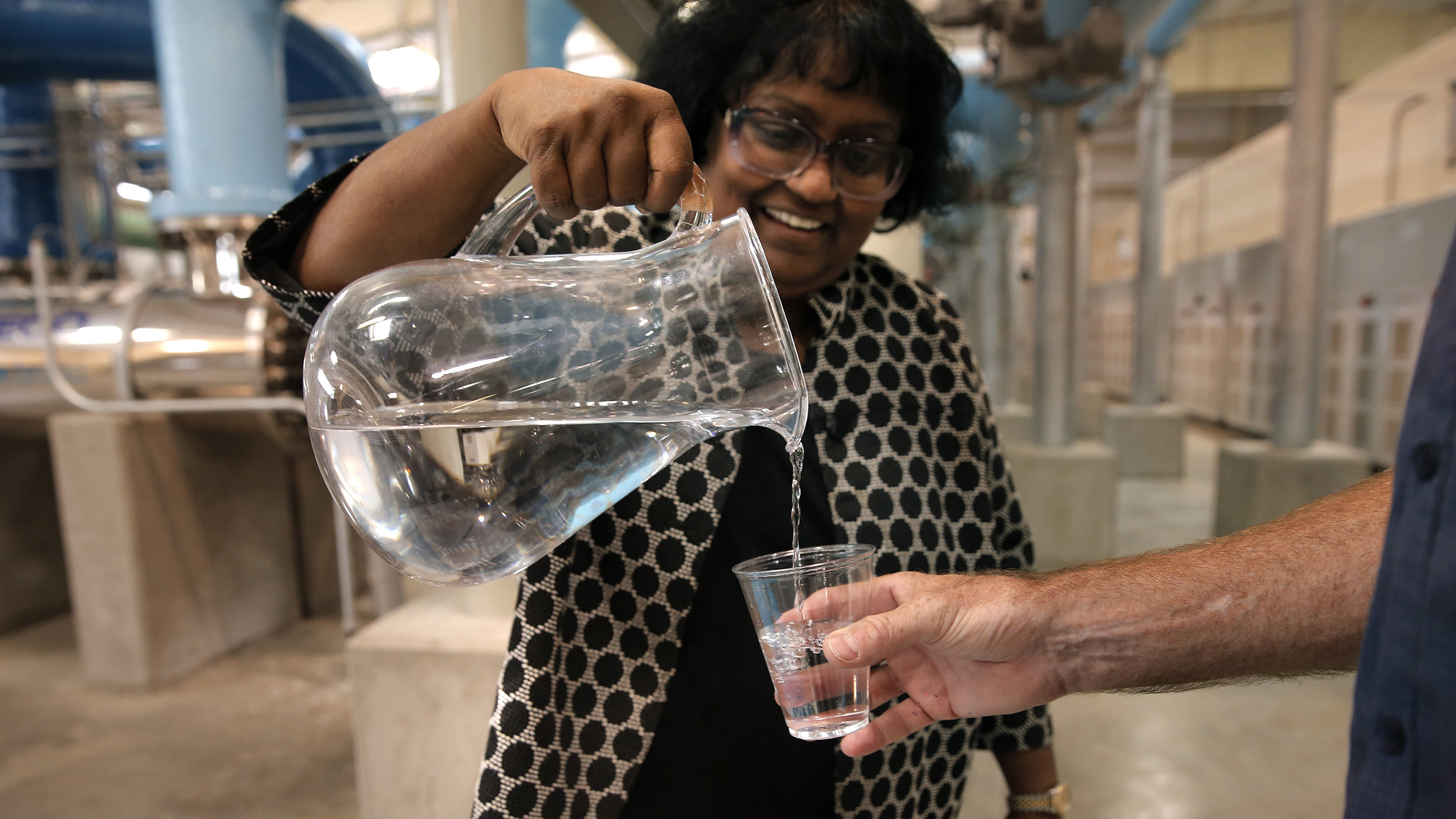
Here in the heart of Silicon Valley, water is in short supply. Santa Clara County, where the plant is located, is home to the state’s booming tech industry. Growing businesses demand water, and John is determined to get them what they desire.
“We want to ensure that the economic engine keeps on churning,” she says with a wide smile. The Silicon Valley Leadership Group, a powerful trade organization that includes corporations like Chevron, Google, and Intel, wrote a letter of support for the purification center when the Santa Clara Valley Water District applied for state grants to help fund the project.
About half of the water used in urban California is used outdoors, largely for irrigating lawns and gardens, and Silicon Valley is no exception. “We spend thousands of dollars on good backyards and front yards, and yet not to be able to maintain it…” John says. “We want to make sure that quality of life continues.”
According to John, the water utility is doing everything it can to stretch existing supplies, which are imported from the Sierra Nevada Mountains, 150 miles away, and pumped from local groundwater. They’re encouraging water-wise landscaping. They’re giving rebates for high-efficiency appliances. They import water from the Sacramento-San Joaquin Delta. They capture rainfall and infiltrate it back into the groundwater basin. But when it doesn’t rain, water capture doesn’t help.
“We are entering the Fourth. Year. Of drought,” John enunciates. Which leads us back to the sewer as an option of last resort.
She starts the tour by the pumps, where treated sewage from the wastewater treatment plant across the street enters the purification center. Silicon Valley’s sewage, like all sewage, is nasty stuff. After standard treatment, it still contains trace amounts of salt from bodily fluids and water softeners, bacteria from feces, pharmaceutical drugs and hormones we take and excrete, and chemicals we use around our homes. That’s not all. Silicon Valley’s treatment plant also accepts industrial wastewater, which contains a slew of different compounds used in processing and manufacturing. Since about 10,000 new chemicals are developed each year, a leading textbook on water reuse, published in 2007, states that knowing exactly which chemicals are in wastewater at any given time is an “unachievable goal.”
When the wind blows just right, the smell of sewage wafts on the breeze from across the street.
John’s low-heeled black boots clack on the cement as she heads to the next stop, a large warehouse. Another set of pumps bringing wastewater over to the purification center whir like airplane propellers. Everything looks spotlessly clean. The place is remarkably devoid of humans. Other than a water quality engineer crouched by one of the valves, a smartphone edging out of the back pocket of her jeans, everything is automated. If something goes wrong, alarms will sound and the equipment will automatically shut down, John says reassuringly.
Poster-sized photos hang from the warehouse ceiling: a smiling woman with a full glass of water, a sprinkler on a sports field, freshly harvested produce. On the right are long banks of filters, standing nearly 8 feet tall, which strain out anything bigger than 0.1 micron, which is about 1/1000th the width of a human hair. On the left are stacks of pipes that house reverse-osmosis membranes.
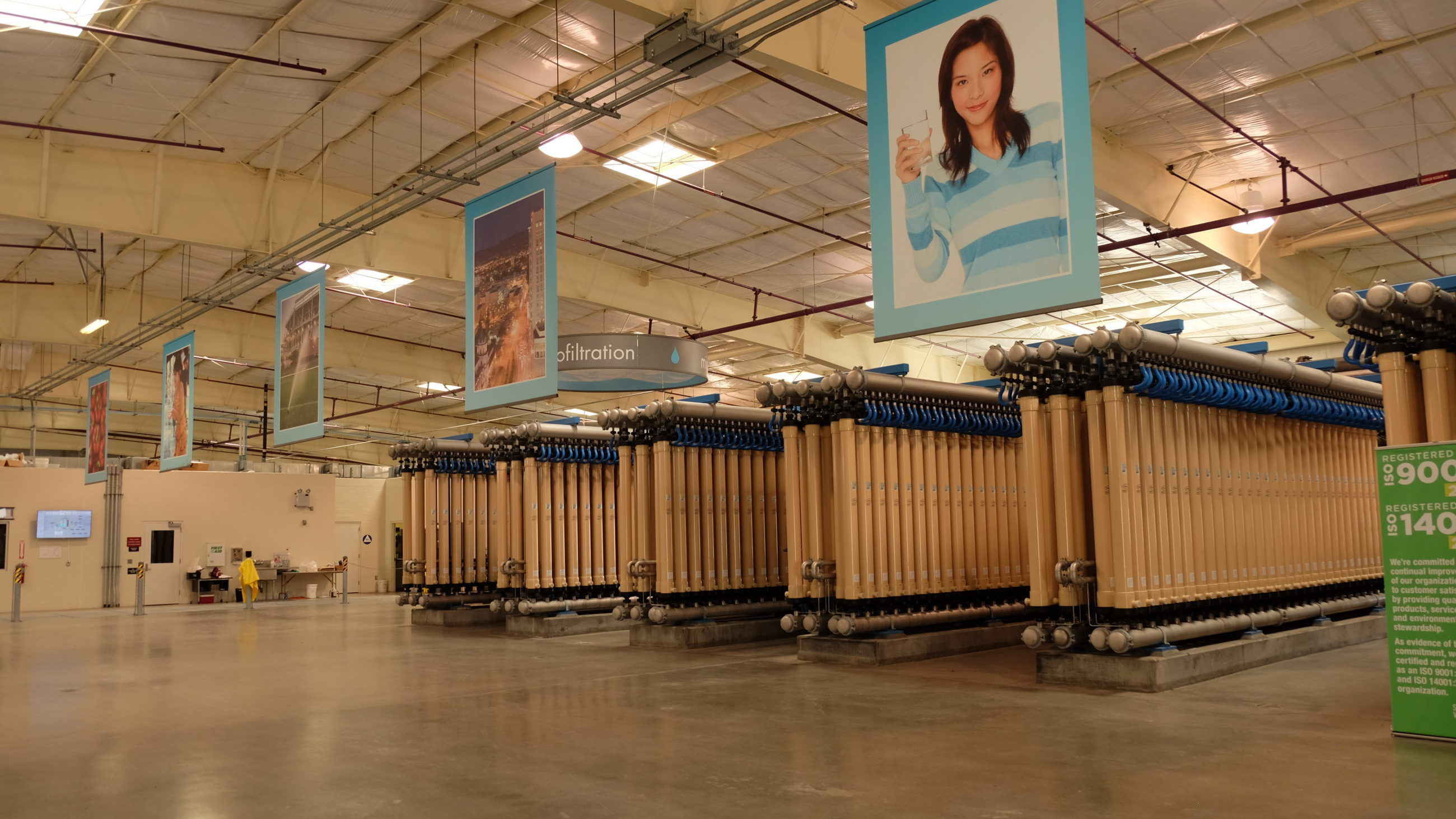
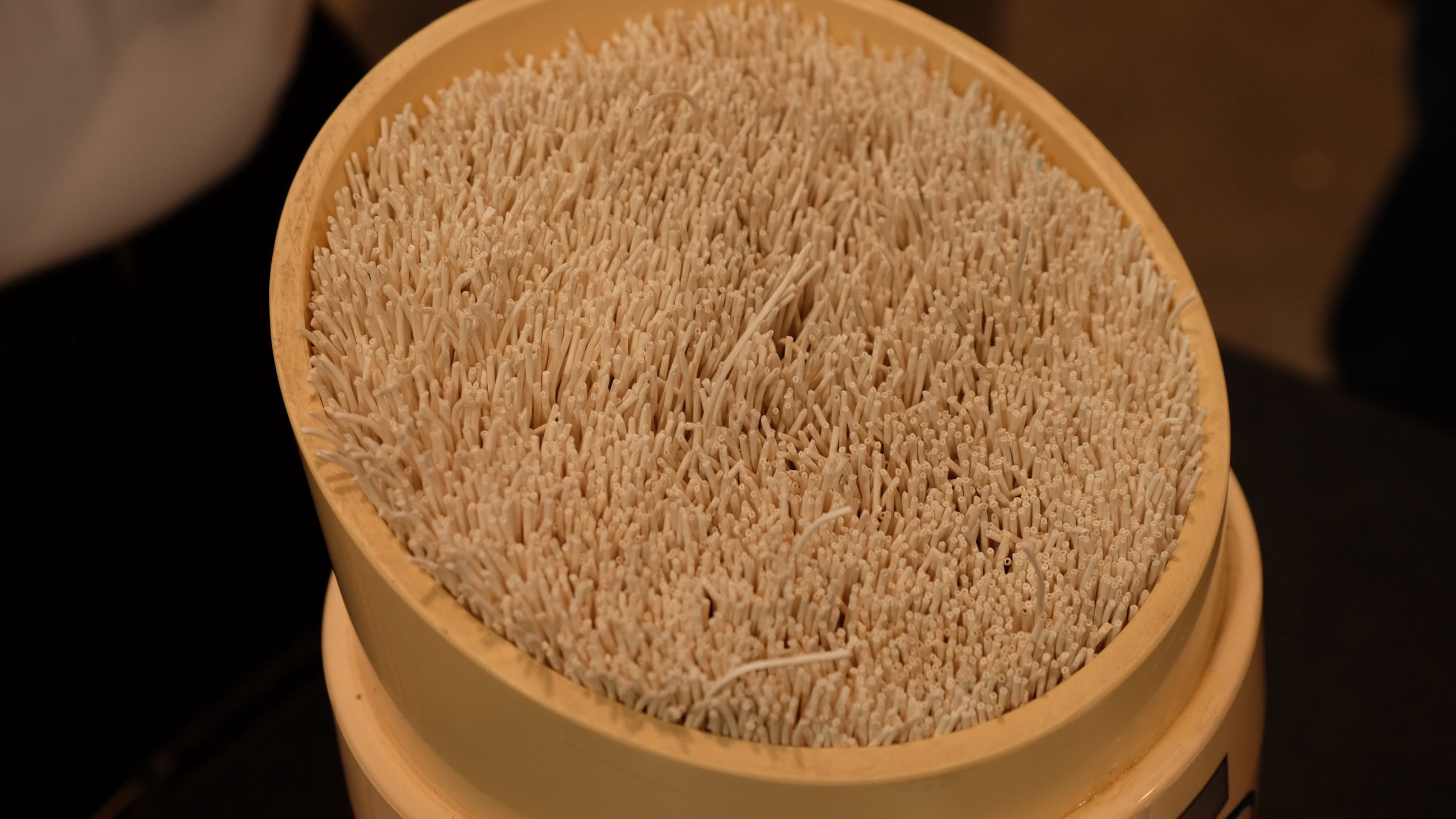
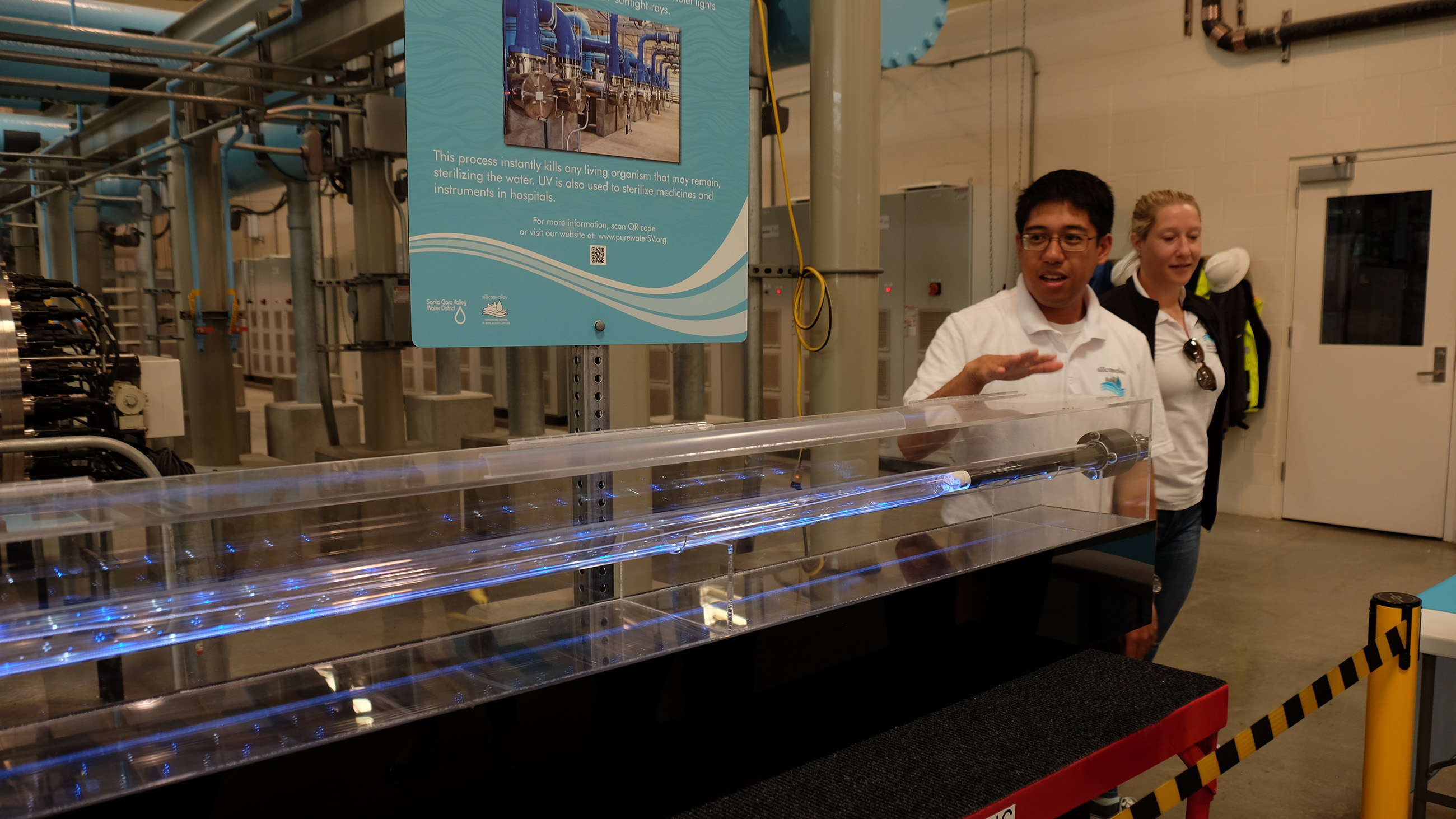
Reverse osmosis works by pushing contaminated water against a semi-permeable membrane at high pressure. Ideally, only water molecules are forced through. Everything stuck on the wrong side of the membrane — that is, anything wider than 0.0001 microns across, including salts, microorganisms, viruses, and contaminants from most personal care products and pharmaceuticals — is sent back through the wastewater treatment plant across the street to either be recycled or treated again before being released into San Francisco Bay.
In reality, mostly only water molecules get through reverse-osmosis membranes. The technology filters out most contaminants but not all of them. Some especially small molecules, like acetone (the stuff in nail polish remover), 1,4 dioxane (an industrial solvent), or n-nitrosodimethylamine (formerly used to manufacture rocket fuel), can potentially slip right through.
How well reverse osmosis works to filter out other contaminants, like pharmaceuticals and pesticides, depends on the specific chemical and the amount of pollution in the water. The water reuse textbook states that reverse-osmosis membranes strain out 90 to 96 percent of the toxic pesticide atrazine, for example, and 85 to 95 percent of the poisonous element arsenic. Most of the time, this means there is a very small amount of these pollutants left in the water after reverse osmosis. But if there were an atrazine spill, and a lot of the pesticide was washed into the sewer, then a potentially harmful dose of the toxin could make it through reverse osmosis.
The final step of treatment is a blast of ultraviolet light. If any germs or harmful chemicals make it through reverse osmosis, the UV light is supposed to scramble their DNA or shatter their molecular bonds. If the water is used for drinking, advanced oxidation processes will be added to break down any remaining toxic organic compounds. John declares these combined water treatment technologies “fail-safe.” Yet even “fail-safe” engineered systems — like the Titanic or the Fukushima nuclear power plant — can malfunction under unusual circumstances.
Near the end of the tour, there’s a table set up with several beakers of water on it. Each beaker holds water from a different part of the process. When the wastewater first enters the purification center, it’s slightly cloudy, with a hint of a golden-brown hue. (One tries not to think about what made it that color.) By the time it leaves, it really is completely clear, and completely odorless (and tasteless, stripped of the minerals that normally flavor tap water). Then it’s off to a massive holding tank before being sent out to customers through non-potable pipes — for now.
When John describes the process, she sounds like a preacher talking about redemption. “We don’t have to be stranded in a state where we’re at the beck and call of hydrologic cycles,” she says, her voice resonating. “Will it rain, will it not rain? Maybe we can change that paradigm.”
Improving on such hydrologic cycles is hardly a new idea in California. For nearly a century the state has been building dams and hundreds of miles of canals to transfer water and snowmelt from the wetter regions of California to its arid cities and farms. Based on the host of unforeseen ecological outcomes that arose from building dams, one can’t help wondering if water recycling will also have unexpected consequences.
Florence Bonvin studies the traces of chemicals that get through the advanced water treatment technologies the Silicon Valley Advanced Water Purification Center and similar facilities use. Athletic, with an easy smile, she specializes in a set of tiny chemical molecules that aren’t dangerous, but that can leave a telltale smell in highly treated wastewater.
One of these chemicals is vanillin, the primary component in vanilla bean extract, which smells sweet and delicious. “But most of them are not as nice,” Bonvin says. “They’re musty, earthy, medicinal.” She knows that if recycled water smells bad, people won’t want to drink it.
Human noses are remarkably sensitive chemical detectors. “Even if we remove 99.9 percent of a specific compound during treatment, [that might] not be sufficient to have levels below the odor threshold,” Bonvin explains. The odor threshold is the lowest concentration at which 50 percent of a human panel can sniff out one of these chemicals. And for many of the chemicals she studies, the threshold is less than 10 parts per trilion. That’s like being able to smell one grain of wild rice in 3.4 million pounds of white rice.
A promotional video produced for the Advanced Silicon Valley Water Purification Center makes the case for such systems.
Bonvin recently completed a stint as a postdoctoral researcher at UC Berkeley. (She now works in research for a private potable reuse company in Switzerland.) In the spring of 2015, she gives a tour of her lab on the second floor of a bulky concrete building on the Berkeley campus.
Bonvin moves gracefully through the lab to her workbench, where vials of perfectly clear water, which she has spiked with minute amounts of different chemicals, are lined up by on a lab bench, ready for analysis.
The instrument she uses for the analysis is topped by a little red box, which shakes rhythmically. It mixes the water in one of the vials around a thin wire, which sticks into the fluid and will trap chemicals on its surface. Those chemicals are injected into an instrument called a gas chromatograph, where they can be separated based on their different characteristics. By measuring their different masses, Bonvin is able to detect ever-lower concentrations of some of the smelly chemicals. But she concedes that there are many more potential chemical contaminants for which no measurement method has yet been developed.
And if there isn’t a way to test for them, they could make it past treatment.
The smelly molecules that come through wastewater treatment are only part of the problem. When these chemicals get through advanced treatment, it means that other, more dangerous, compounds have likely gone through as well. “On the one hand, you have the taste and odor, which are not dangerous to human health, but aesthetically, could alter public perception of the water,” Bonvin says. “And then on the other side you have the solvents, which we can’t really see or taste, but could have effects on human health.”
Solvents are a class of chemicals used for a range of purposes from dry cleaning to paint thinning to manufacturing. Many of them are small molecules, so they can slide untreated through reverse osmosis. And many of them are poisonous to humans.
Solvents and other industrial chemicals that can disrupt hormones in the body’s endocrine system are particularly worrisome. With a litany of dreadful health effects like cancer, birth defects, and infertility, these endocrine-disrupting chemicals can be extremely toxic even at the very low levels that could potentially get through even the most advanced water treatment, including reverse osmosis and advanced oxidation.
“It’s not reassuring to me to hear that chemicals are present “only” at parts per trillion levels,” said Ted Schettler, a physician and the science director of the non-profit Science and Environmental Health Network. “There are many chemicals that you would worry about at parts per trillion.”
Parts per trillion is really tiny — like having one drop of poison spread throughout 20 Olympic-size pools. For some chemicals, we don’t even have analytical methods that can accurately detect such low concentrations. Yet even such a minuscule amount can have an effect on our bodies. “Our bodies’ hormone systems operate at low parts per trillion levels,” Schettler explained. “The hormone receptors are exquisitely sensitive to even minor shifts in those concentrations.”
The Environmental Protection Agency counts about 85,000 industrial chemicals registered for current use, but requires additional toxicity testing for only about 200 of them. Pesticides in home and garden products, which are regulated by the EPA’s Federal Insecticide, Fungicide, and Rodenticide Act, can also make their way down the drain, as can FDA-regulated pharmaceuticals, which people excrete naturally after use.
This all means that tens of thousands of different chemicals may be present in sewage before treatment — and after treatment we still don’t have a full idea of the range of chemicals that get through. “What you really need to do is figure out what’s in the water, and at what levels,” Schettler said.
But that’s easier said than done.
No one knows exactly what’s in sewage at any given time — people and businesses don’t dump things down the drain on a regular schedule. It’s very hard for a water scientist or public health official to know everything to look for. And since detecting tiny amounts of chemicals relies on identifying them by their unique characteristics, it’s nearly impossible for them to recognize a chemical they weren’t already looking for.
Of the contaminants that are detected in recycled water, many of them have unknown health effects. “There’s a lot [of chemicals] out there, that show up in monitoring, but that we don’t really know what the broad effects might be from them,” said David Spath, the former chief of the Division of Drinking Water and Environmental Management for the State of California. Even more troubling is that a combination of chemicals can be more toxic than the sum of their parts. It could be a big problem, according to Spath, “if you get three or four chemicals that are all endocrine disruptors that disrupt the same endocrine process, or if you have two or three chemicals that are all carcinogens that result in the same carcinogenic endpoint.”
Only one major epidemiological study has documented the human health effects of drinking recycled water. Conducted by a private research corporation and commissioned by a water utility, the study is now 25 years old. (“The chemicals that they’re now looking for weren’t even in anybody’s vocabulary at the time,” Spath said.) The science was inconclusive: Because of confounding factors like smoking and alcohol consumption, researchers couldn’t prove or disprove the notion that drinking recycled water caused cancer or heart disease. The fact that some chemicals could disrupt hormone functioning hadn’t yet been discovered at the time the study was published.
“It is a difficult situation,” Spath added. He sighed. “You’ve got the pressure to move forward, and in some cases the need to move forward with these types of uses, because of the water resources situation in California.”
The timeline for sending Silicon Valley’s recycled water directly into the drinking-water pipes is uncertain, pending the state’s development of regulations for direct potable reuse, which are estimated to be completed in the next few years.
In the meantime, the water agency plans to stick with indirect reuse: sending the recycled water back into the aquifer, and then pumping it out for drinking. And Garth Hall, Deputy Operating Officer of the Santa Clara County Water District, estimates Silicon Valley will be drinking this recycled water by 2020.

After Governor Brown mandated in early April 2015 that all California water districts cut their water use by 25 percent, Silicon Valley residents were limited to watering their gardens twice a week. Grassy medians turned brown. Burbling fountains fell silent.
But 750 sites in Silicon Valley were spared the water restrictions. These sites, ever lush and green, include various city parks, the Intel corporate campus, and the grounds of Great America amusement park. As customers of the South Bay Water Recycling Program, some of the water they use comes from the Silicon Valley Advanced Water Purification Center.
Walking through two of these city parks on a Sunday afternoon during the dry spring of 2015, most park-goers had no idea recycled water was currently used for irrigation or that Silicon Valley was planning to use recycled water for drinking in the near future.
“I think recycled water is a great thing,” said LaRee Rouse of Santa Clara, as she watched her children climb on a play structure surrounded by the verdant lawns of Lick Mill Park. She paused, “But I don’t know much about drinking recycled water, how good it is for you or not. For watering grass it makes sense.”
For Ana Reyes, who recently moved to San José from San Antonio, Texas, people who live in an arid environment have to learn to be thrifty with water. “I can’t believe y’all are just doing conservation efforts now,” she said. But if it comes down to it, she says she would drink recycled water. “I’m fine with it as long as it’s safe,” she added.
Reyes isn’t alone. In a 2014 poll from the non-profit National Resources Defense Council, 64 percent of the 1,000 Californians surveyed said “building local water-recycling plants is a very important water supply solution.” But when it comes to the long-term health effects of drinking recycled water, no one really knows for sure.
California has since lifted its statewide water restrictions and allowed counties to set their own goals, but the Santa Clara Valley Water District is still aiming to cut water use by at least 20 percent. The state legislation is moving to develop regulations for the use of treated sewage as a drinking water supply. The recycled water unit chief for the State Water Resources Control Board, Randy Barnard, said in 2015 that the current advanced treatment technologies, like those at Silicon Valley’s Advanced Water Purification Center, are covering all contaminants and that testing has found “no measurable health risk.”
Knowing that there’s no good data on the long-term health effects of ingesting trace amounts of countless chemicals and pharmaceuticals in recycled water, Spath, the retired chief of the Division of Drinking Water, is wary. “I think prudence would argue for a slow, measured process that assesses the risk,” he said. In his view, recycled water should be used for the lowest-risk purposes, like watering plants, first. Part of the discussion about integrating recycled water directly into our drinking water supplies should include “an understanding of the potential for future health consequences,” he wrote in an email.
Last December, California water regulators released a report to the State Legislature on the feasibility of developing state-wide criteria for direct potable water reuse, based on the recommendations of an expert panel and an advisory board convened by the state. They concluded that while creating regulations to recycle sewage into drinking water is certainly feasible, there is a need for better methods to identify potential contaminants and to study their effects on our health.

A draft analysis concluded that while creating regulations to recycle sewage into drinking water is certainly feasible, better methods are needed to identify potential contaminants and to study their effects on our health.
After a draft of that report came out in September, Barnard took a more cautious stance. In an email dated October 3, 2016, he stated that while direct potable reuse has great potential, there are “very real scientific and technical challenges that must be addressed before DPR can be consumed by public water system customers.”
But the state isn’t planning to wait for this research to be done before passing regulations to allow direct potable reuse; the report (which was supported by “significant time, effort, and investment” from water reuse advocacy groups) concluded that the research could be done concurrently with developing regulations.
While Barnard could not say when such regulation will be passed, Silicon Valley, along with other California cities, continues to move forward with plans to use recycled water for drinking. During her tour, Pam John showed a map of Santa Clara County that gave a glimpse into the future. Different colored lines squiggled across the city streets, marking the current location of drinking water pipes in green and recycled water pipes in purple. John had delineated all the places where recycled water produced at the purification center could be connected directly to drinking water pipes.
“There are options,” she said, smiling.
In the two and a half years since the Silicon Valley Advanced Purification Center came online, Pam John has retired but the plant’s ambition and influence have kept growing.
In keeping with its mission as a demonstration facility, the plant hosts visitors from water districts throughout the state and international guests who come to learn about their technology, and their marketing. Last June, water officials from the City of Pleasanton, which is considering building a similar facility, came to discuss their options.
This time their host was a young engineer, Paolo Baltar, fresh out of graduate school but cool and confident, and Marta Lugo, the center’s polished and knowledgeable outreach coordinator. The Pleasanton officials were just as keen on the details of the plant’s public outreach as its technology. The Dublin San Ramon Services District, which provides wastewater treatment for the City of Pleasanton, had tried to implement an indirect potable reuse project years ago, an effort abandoned in the face of opposition from citizens disturbed at the prospect of drinking purified sewage. But that was before the drought. Baltar and Lugo assure them that things are different now. People understand the value of a reliable local water source, even if the source is a bit icky.
Water engineers frequently point out that in comparison to some other water supplies, like imported water from the Colorado River, recycled water actually contains fewer known contaminants, like nitrates or arsenic. Many people are already drinking recycled water treated much less thoroughly than what happens at the Santa Clara plant. Besides the aquifers in Orange County and the lake water in Texas, hundreds more are located downstream from sewage effluent, so residents’ water supply contains wastewater that hasn’t been treated to recycled water standards so much as diluted, what water officials call “de facto” or “unplanned” potable reuse.
“Do you tell people they’ve been drinking recycled water for 50 years?” one of the Pleasanton officials asked Lugo. “How much do you leverage that?”
“We don’t focus too much on de facto recycled water,” Lugo said. “We don’t want to get them focused on ‘Oh, what’s in the Delta water?’ or go down that path.”
Instead, she says they remind their customers, “All water on Earth is recycled. There’s no new fresh water anywhere.”










